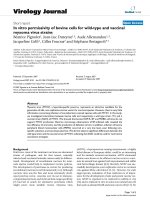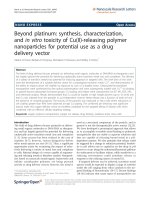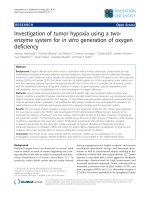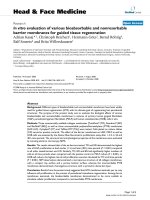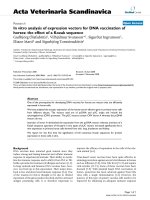In vitro response of promising sugarcane varieties for salinity tolerance through callus culture
Bạn đang xem bản rút gọn của tài liệu. Xem và tải ngay bản đầy đủ của tài liệu tại đây (127.91 KB, 9 trang )
Int.J.Curr.Microbiol.App.Sci (2019) 8(10): 2009-2017
International Journal of Current Microbiology and Applied Sciences
ISSN: 2319-7706 Volume 8 Number 10 (2019)
Journal homepage:
Original Research Article
/>
In vitro Response of Promising Sugarcane Varieties for Salinity Tolerance
through Callus Culture
V. Patel Devangi*, S.C. Mali2, J. Udutha2 and Patel Nilpa3
1
Department of Genetics and Plant Breeding, 2Main Sugarcane Sugarcane Research,
3
Department of Plant Molecular Biology and Biotechnology,
Navsari Agricultural University, Navsari, India
*Corresponding author
ABSTRACT
Keywords
Sugarcane, Salinity,
Tissue culture, in
vitro, Somaclonal
variation
Article Info
Accepted:
15 September 2019
Available Online:
10 October 2019
Present investigation was carried out to screen two promising sugarcane varieties CoN
13073 and CoN 09072 for salinity tolerance through callus culture. Various physiological
and morphological parameters was studied, maximum shoot length was observed at 2.0 %
NaCl concentration treated to callus at 65 days of culturing in variety CoN 13073, similar
trend was observed for root length and leaf number per plant in variety CoN 13073 at 2.0
% NaCl concentration.. Very little differences observed in shoot: root ratio in variety CoN
09072, while there was much difference was observed in shoot : root ratio at various levels
of NaCl in variety CoN 13073S. Leaf area, chlorophyll content and Na:K ratio were
decreased with increased the concentration of NaCl in both the varieties Shoot regenerated
under high concentrations of NaCl shown maximum chlorophyll content and leaf area in
both the varieties. In comparatives studies, CoN 13073 responded positively to higher
concentrations for all the characters studied.
Introduction
Sugarcane industry is the second largest agrobased industry in India. It is grown under
varied agro-climatic conditions, hence it faces
various biotic and abiotic stresses that impact
the productivity in significant way. Salinity is
one of the major abiotic stress which greatly
affects the sugarcane productivity and
recovery.
The
soils
with
electrical
conductivity (EC) less than 4 dsm-1are
generally considered as salt-free, whereas soil
with EC range between 4-8 dsm-1are
generally considered as salty soil. Salinity is a
significant factor that affects crop production
and agricultural sustainability worldwide,
since about 10 % of the land surface and 50 %
of all irrigated land in the world are prone to
salinity (Flowers et al., 2010). Salt stress
affects several aspects of plant physiology by
its osmotic and ionic components (Munns and
Tester, 2008).
Sugarcane is a typical glycophyte and hence
exhibits stunted growth or no growth under
salinity, with its yield falling to 50% or less
2009
Int.J.Curr.Microbiol.App.Sci (2019) 8(10): 2009-2017
than its true potential (Subbarao and Shaw,
1985). Salinity in the root zone of sugarcane
decreases sucrose content, through its effect
on both biomass and juice quality (Lingle and
Wiegand, 1996). Salinity may interfere with
sugar production in two major ways, first by
affecting growth rate and yield of the cane
secondly by affecting the sucrose content of
the stalk (Rozeff, 1995). In any crop
improvement program prime importance is
given to yield and quality parameters.
Development of high yields and high sugar
recovery genotypes in sugarcane through
conventional breeding program is the time
consuming. So, In vitro screening and
evaluation of sugarcane genotypes for salinity
tolerance is a substitute improvement
program. Sugarcane is an important cash crop
of South Gujarat region. Gujarat has 1600 km
costal area which is largest area among all
states in India, so some area of sugarcane
cultivation affected by salt accumulated
through sea water as well as improper
irrigation practices and sugarcane - paddy crop
rotation is very common in the state which
leads to excessive use of water causing soil
salinity. This situation decreased the
production as well as area of sugarcane
cultivation in South Gujarat region. So, there
is a need to develop resistant/tolerant
somaclones of sugarcane varieties. So, present
investigation was carried out to screen two
promising sugarcane varieties CoN 13073 and
CoN 09072 for salinity tolerance through
callus culture at sugarcane tissue culture
laboratories, Main Sugarcane Research
Station, Navsari Agricultural University,
Navsari.
Various
physiological
and
morphological parameters was studied.
Materials and Methods
The commercial cultivars of sugarcane
13073 and CoN 09072 grown in Gujarat
used as the source of explants in
experiment. The explants were obtained
CoN
were
this
from
Main Sugarcane Research Station, Navsari
Agricultural University, Navsari. The direct
leaf whorl and meristem of sugarcane were
used as explants and these explants were true
to type, visually healthy and disease free.
Disease-free and actively growing cane tops
were selected from five months old sugarcane
crop as an explant. Cane tops with the
growing apices were cut approximately 10 cm
long and washed thoroughly in running tap
water for 30 minutes. Outer sheaths of cane
tops were removed by wiping the sheath with
rectified spirit. The shoots were then washed
with soap water for about five to six minutes
in a sterile 1 liter conical flask followed by
cleaning the materials with distilled water.
The shoots were rinsed in 5 per cent sodium
hypochlorite for 10 minutes.
Then shoots were thoroughly rinsed in 70 per
cent ethanol for 30 seconds followed by
sterilize double distilled water for four to five
times till ethanol was completely washed out
from the surface of material. Surface
sterilization was performed by using 0.1 per
cent mercuric chloride solution. Shoots were
shaken vigorously for 5 minutes. Then the
container was taken to a laminar clean air
station. They were rinsed three to four times
with sterile double distilled water to remove
all traces of chemicals. The isolation of shoot
apex was done by carefully removing the two
to three outer whorls of the developing leaves
with the help of a sterile sharp blade. The
second innermost whorls of developing leave
cut in to small pieces of approximately one
centimeter length with the help of a sterile
sharp blade and utilized as explant for callus
induction on MS medium supplemented with
different concentrations of 2,4-D (0,1, 2, 3, 4,
and 5 mg/l) in different treatments along with
2 mg/l NAA as constant for callus induction
Good quality callus generated from leaf whorl
and meristem was selected for further
experimentation to impose different levels of
NaCl concentration and to check the response
2010
Int.J.Curr.Microbiol.App.Sci (2019) 8(10): 2009-2017
to salinity tolerance on the basis of in vitro
evaluation procedure in both the varieties. In
regeneration medium, NAA 2 mg/l + BAP
1mg/l kept constant in all the treatments.
Transfer the regenerated shoots on rooting
medium i.e., MS + NAA (2mg/l) + BAP
(1mg/l) + different concentration of NaCl.
Incubate the culture either in the incubator or
growth room maintained at temperature 25+
20C, with florescent light (3000-5000 Lux), 16
hrs light/ 8 hrs dark regimes and possessing
good relative humidity (60-80 %). The best
and healthy plantlets were selected as tolerant
somaclonal variants for the next evaluations.
After successful regeneration of multiple
shoots at different levels of NaCl
concentration in MS medium. The plantlets
were shifted to polythene bags with sand +
soil + compost (1:1:1) at primary hardening.
Polythene bags were irrigated at alternate days
and the irrigation water was incorporate with
different levels of NaCl concentration to
evaluate salinity tolerance at primary
hardening considering morphological and
physiological parameters.
a Chlorophyll Concentration Index (CCI)
value that was proportional to the amount of
chlorophyll in the sample of each treatment.
The leaves from plants selected from each
treatment were used for the estimation of leaf
area after 25 days of planting. Leaf area was
measured by leaf area meter (Model LI3000,
LI-COR, USA) and expressed as cm2. Total
number of green leaves on the plant from each
treatment were counted at 60 days after
planting and recorded. Shoot root ratio was
estimated by dry weight basis. The potassium
and sodium contents were estimated by flame
photometer (Jenway PFP 7, ELE Instrument
Co. Ud.) method and expressed as ratio on the
basis of dry weight. Survival per cent was
calculated on the basis of number of plantlets
survived from the total number at each
treatment combination.
Statistical analysis
The data generated from the various in vitro
experiments were subjected to statistical
analysis in Completely Randomized Design
(CRD).
Observation recorded during experiment
Results and Discussion
Length of regenerated shoots from callus
developed on different treatments medium,
measured in centimeter after 25 days for
fourth subculturing and length of shoot was
measured from collar region to the tip of top
most leaf. Root length of in vitro plantlets was
measured in centimetre. These observations
were recorded at the 30 day after inoculation
on rooting media. The length of the root was
measured from collar region down to tip of the
longest root. Plant height (cm) was recorded
under primary hardening after 25 days of
planting. Chlorophyll content index was
recorded with help of chlorophyll content
meter (CCM – 200 plus manufactured by
Apogee Instrument). It measures the
absorbance of both wavelengths and calculates
Shoot length (cm)
In variety CoN 13073 maximum shoot length
was observed in MS medium supplemented
with 2 mg/l NAA + 1 mg/l BAP + 2.0 % NaCl
in treatment T5 (5.8 cm), followed by MS
medium without NaCl in treatment T1 (5.2
cm) and treatment T2, MS + 0.5 % NaCl (4.8
cm). Whereas minimum shoot length was
observed in treatment T6 MS supplemented
with 2.5 % NaCl (3.5 cm).
In variety CoN 09072 maximum shoot length
was observed in MS medium supplemented
with 0.5 % NaCl in treatment T2 (4.8 cm),
followed by MS + 1.0 % NaCl in treatment T3
(4.6 cm) and MS + 1.5 % NaCl in treatment T4
2011
Int.J.Curr.Microbiol.App.Sci (2019) 8(10): 2009-2017
and without NaCl in treatment T1 (4.4 cm).
Whereas minimum shoot length was observed
in MS medium supplemented with 2.5 % NaCl
concentration in treatment T6 (3.4 cm). MS
medium
without
NaCl
concentration
registered above to average shoot length.
The plantlets regenerated from callus
supplemented with MS medium + different
levels of NaCl showed significant differences
in shoot length. Among both the varieties CoN
13073 exhibited maximum shoot length at
higher NaCl concentration compared to
variety CoN 09072. Very little differences in
shoot length were observed in variety CoN
09072. The MS medium with 2% NaCl
showed maximum shoot length in variety CoN
13073, followed by MS medium without
NaCl. Whereas decline in shoot length was
observed with the increase in NaCl
concentration in variety CoN 09072. At higher
concentration of NaCl 2.5% both the varieties
responded negatively and resulted reduced
shoot length. These results are agreement with
Wahid and Ghazanfar (2006) and Ather et al.,
(2009). The minimum shoot length was
observed in plantlets treated with 2.5% NaCl.
The saline solution may be at a higher water
potential like sea water. Plants challenged by
this magnitude of water potential developed
through medium, so the leaf is unable to meet
the transpirational demands. Somaclonal
variation appears due to various biological
phenomena like, chromosomal aberration,
cytoplasmic changes, mitotic crossing over
and genetic rearrangement. Variation might
have been created during callus formation.
The same was reflected in one of the sub
culture where surprisingly more shoot and root
length was observed even under higher NaCl
concentration. The present finding is in
accordance with Shomeili et al., (2011).
Root length (cm)
The multiple shoots developed from
regeneration media were shifted to rooting
media, ½ MS medium was supplemented with
NAA 2 mg/l + IBA 2 mg/l kept constant and
different NaCl concentrations were imposed to
the culture as per treatment combination.
In variety CoN 13073 maximum root length
was observed in treatment T5 (4.4 cm), where
½ MS medium was supplemented with 2.0 %
NaCl concentration along with NAA and IBA
standard, followed by ½ MS + NaCl 1.0 % in
treatment T3 (4.2 cm). Moderate root length
was observed in ½ MS medium without NaCl
whereas ½ MS medium supplemented with
2.5 % NaCl concentration in treatment T6 (2.2
cm) registered minimum root length.
The response of both the varieties to different
NaCl concentration was highly differential.
Variety CoN 13073 responded positively to
higher NaCl concentration up to 2 % for root
length. Whereas variety CoN 09072 responded
positively to NaCl concentration up to 1.0 %
then after there is reduction in root length was
observed. In both the varieties minimum root
length was observed when plantlets developed
from callus supplemented with 2.5 % NaCl.
Among both the varieties CoN 13073
exhibited moderate in root length to higher
NaCl concentration. These results are in
agreement with Akhtar et al., (2003) and
Shomeili et al., (2011). According to Mathur
et al., (2008) root growth is the prime
parameter that affected by salinity condition.
At high saline condition rapid inhibition of
root growth was observed and hence reduction
in uptake of water and essential nutrients can
be seen at field condition.
Plant height (cm)
Maximum plant height was observed in
treatment T5 (21.4) where rooting mixture was
supplemented with 2.0 % NaCl concentration
in variety CoN 13073 followed by treatment
T3 (20.6 cm). While minimum plant height
was
registered
in
rooting
mixture
supplemented with 2.5 % NaCl concentration
2012
Int.J.Curr.Microbiol.App.Sci (2019) 8(10): 2009-2017
in treatment T6 (10.6 cm). Whereas average
plant height was observed in rooting mixture
without NaCl concentration in treatment T1
(16.5 cm).
(4.54) and T3 (4.27). while minimum
chlorophyll content index was observed in the
plantlets developed from the rooting mixture
with 2.5 % NaCl in treatment T6 (3.67).
In variety CoN 09072, rooting mixture
without NaCl concentration registered
maximum plant height in treatment T1 (14.4
cm) followed by rooting mixture with 2.0 %
NaCl concentration in treatment T5 (13.5 cm)
and rooting mixture with 0.5 % NaCl
concentration in treatment T2 (12.6 cm).
Whereas minimum plant height was recorded
in rooting mixture with 2.5 % NaCl
concentration in treatment T6 (8.2 cm).
The plantlets regenerated from callus culture
were imposed to different NaCl concentration
in rooting mixture and observed low
differences among chlorophyll content in both
varieties. In variety CoN 09072 control
showed maximum chlorophyll content.
Increased in the level of NaCl the chlorophyll
content was decreased gradually. These results
are agreement with Wahid and Ghazanfar
(2005) and Shomeili et al., (2011). The
minimum chlorophyll content was observed in
plantlets treated with 2.5 % NaCl. Chlorophyll
content can be used as a sensitive indicator of
the cellular metabolic state, thus its decrease
signifies toxicity in tissues due to
accumulation of ions.
Both the varieties responded poorly to higher
NaCl concentration at primary hardening
level. Similar results were noticed by Shomeili
et at., (2011). Among both the varieties effect
of salinity in the plant height was not
significant in CoN 13073 that indicate at high
sodium levels up-taking of nutrients from the
rooting mixture were not inhibited and water
potential retained at cellular level at saline
condition.
Chlorophyll content index
The plantlets developed from callus culture in
MS medium supplemented with different
NaCl (0 to 2.5%) concentration registered
maximum chlorophyll content index in
treatment T2 (5.40), followed by treatment T1
(5.27) and T3 treatment (4.87). While plantlets
registered from callus culture and rooting
mixture supplemented with NaCl 2.5%
concentration resulted minimum chlorophyll
content index in treatment T6 (3.70) in variety
CoN 13073.
In variety CoN 09072 maximum chlorophyll
content index was observed in plantlets
developed from rooting mixture without NaCl
(%) and registered maximum chlorophyll
content (4.86) followed by treatments T2
Leaf area (cm2/plant)
In variety CoN 13073, rooting mixture
without NaCl registered maximum leaf area T1
(41.6 cm2), followed by treatment with NaCl
concentration 0.5 % in treatment T2 (40.7 cm2)
and with 2.0 % NaCl concentration in
treatment T5 (40.4 cm2). Minimum leaf area
was registered in treatment with 2.5 % NaCl
concentration T6 (32.6 cm2).
In variety CoN 09072 maximum leaf area was
registered in rooting mixture without NaCl
concentration in treatment T1 (40.4 cm2),
followed by 0.5 % NaCl concentration in
treatment T2 (38.5 cm2) and with 2.0 % NaCl
concentration in treatment T5 (36.4 cm2).
Whereas minimum leaf area was registered
with 2.5 % NaCl concentration in treatment T6
(32.3 cm2).
High leaf area was observed in control
condition (0 % NaCl) while, minimum leaf
area was observed where plantlets treated with
2013
Int.J.Curr.Microbiol.App.Sci (2019) 8(10): 2009-2017
2.5 % NaCl in both the varieties. Similar
results were observed by Wahid (2004),
Shomeili et al., (2011) and Reena et al.,
(2017).
Leaf number per plant
Rooting mixture supplemented with 2.0 %
NaCl registered maximum number of leaves in
treatment T5 (3.4), followed by the rooting
mixture supplemented with 0.5 % NaCl in
treatment T2 (3.0) and rooting mixture with
1.5 % NaCl in treatment T4 (2.8) in variety
CoN 13073. Whereas moderate leaf number
was observed in rooting mixture without NaCl
and minimum leaf number was registered in
rooting mixture supplemented with 2.5 %
NaCl in treatment T6 (2.0).
In variety CoN 09072, rooting mixture
supplemented with 0.5 % NaCl registered
maximum number of leaves in treatment T2
(2.6) followed by rooting mixture with 2.0 %
NaCl in treatment T5 (2.4) and treatment T3
(2.2). Whereas rooting mixture with 2.5 %
NaCl registered minimum number of leaves in
treatment T6 (1.5).
The plantlets regenerated from MS medium
supplemented
with
different
NaCl
concentration showed narrow differences
among different treatment for leaf number
(Table 1) in variety CoN 09072. Whereas
plantlets regenerated from MS medium
supplemented
with
different
NaCl
concentration showed wide difference among
different treatment for leaf number in variety
CoN 13073. Higher numbers of leaves were
observed in 2.0 % NaCl while minimum leaf
number observed in 2.5 %NaCl in CoN
13073. Whereas higher leaf number were
observed in control condition (0 % NaCl)
while minimum leaf number were observed
when plantlets were treated with 2.5 % NaCl
in CoN 09072. A similar result was observed
by Shomeili et al., (2011) as the increase in
concentration of NaCl leaf number decreased.
Shoot : root ratio
In variety CoN 13073 maximum shoot : root
ratio was observed in rooting mixture with 0.5
% NaCl concentration in treatment T2 (2.4),
followed by rooting mixture with 1.5 %
NaCl concentration in treatment T4 (2.2) and
rooting mixture with 1.0 % NaCl
concentration in treatment T3 (2.0). Whereas
minimum shoot : root ratio was observed in
treatment T6 (1.3) with 2.5 % NaCl
concentration.
In variety CoN 09072 maximum shoot : root
ratio was observed in rooting mixture with 0.5
% NaCl concentration in treatment T2 (1.8),
followed by rooting mixture with 1.5 % NaCl
concentration in treatment in treatment T4
(1.6). Whereas minimum shoot root ratio was
observed in treatment T5 (1.2) with 2.0 %
NaCl concentration.
The plantlets regenerated from callus culture
taken to primary hardening and imposed with
NaCl levels in rooting mixture exposed very
little differences in shoot root ratio in variety
CoN 09072. While there was much
differences was observed in shoot : root ratio
at various levels of NaCl in variety CoN
13073.
Lower concentration of NaCl 0.5 % resulted
higher shoot:root ratio. Whereas higher
concentration of NaCl 2.5 % resulted lower
shoot:root ratio in both the varieties.
In the comparative study, variety CoN 13073
showed superior for shoot: root ratio at higher
concentration of NaCl, at primary hardening.
The increase in value of the shoot:root dry
weight ratio at high NaCl indicates that root
was positively affected by salinity than shoots.
These results are in agreement with Akhtar et
al., (2003) and Shomeili et al., (2011).
2014
Int.J.Curr.Microbiol.App.Sci (2019) 8(10): 2009-2017
Table.1 Response of sugarcane varieties CoN 13073 and CoN 09072 to salt stress
S.No
T1
Shoot length (cm) Root length (cm) Plant height (cm)
Chlorophyll
Leaf area
Leaf number per Shoot : root ratio
Na : K ratio
Survival per cent
content index
(cm2/plant)
plant
Variety Variety Variety Variety Variety Variety Variety Variety Variety Variety Variety Variety Variety Variety Variety Variety Variety Variety
13073 09072 13073 09072 13073 09072 13073 09072 13073 13073 13073 09072 13073 09072 13073 09072 13073 09072
5.20
4.40
2.60
3.00
16.50
14.40
5.27
4.86
41.60
40.40
2.80
2.00
1.80
1.41
0.86
0.78
87.50
70.40
T2
4.80
4.80
3.20
3.20
19.40
12.60
5.40
4.54
40.70
38.50
3.00
2.60
2.40
1.80
0.80
0.84
80.60
64.60
T3
4.20
4.60
4.20
2.80
20.60
10.50
4.87
4.27
34.30
36.10
2.40
2.20
2.00
1.40
0.76
0.80
72.30
58.50
T4
4.40
4.40
3.60
2.40
15.70
10.40
4.62
4.14
36.50
34.50
2.80
2.00
2.20
1.60
0.82
0.68
64.10
54.43
T5
5.80
4.00
4.40
2.10
21.40
13.50
4.20
3.86
40.40
36.40
3.40
2.40
1.80
1.20
0.84
0.74
84.60
50.60
T6
3.50
3.40
2.20
1.80
10.60
8.20
3.70
3.67
32.60
32.30
2.00
1.50
1.30
1.40
0.62
0.70
50.40
36.20
SEm
0.12
0.12
0.10
0.01
0.44
0.21
0.01
0.01
0.45
0.56
0.01
0.02
0.01
0.01
0.01
0.01
0.57
0.58
CV
0.37
0.37
0.33
0.05
1.36
0.67
0.05
0.04
1.39
1.72
0.04
0.06
0.05
0.04
0.05
0.05
1.75
1.79
CD
4.47
4.87
5.55
1.16
4.41
3.26
0.69
0.59
2.08
2.67
0.95
1.83
1.80
1.88
4.17
4.17
1.34
1.80
T1 = 0 % NaCl, T2 = 0.5 % NaCl, T3 = 1.0 % NaCl, T4 = 1.5 % NaCl, T5 = 2.0 % NaCl, T6 = 2.5 % NaCl
2015
Int.J.Curr.Microbiol.App.Sci (2019) 8(10): 2009-2017
Na : K ratio
In variety CoN 13073 plantlets developed
without NaCl in the rooting mixture
registered maximum Na : K ratio in treatment
T1 (0.86) followed by plantlets developed
from rooting mixture with 2.0 % NaCl
concentration in treatment T5 (0.84) and
plantlets developed from 1.5 % NaCl
concentration in treatment T4 (0.82). Whereas
minimum Na : K ratio was observed in
rooting mixture with 2.5 % NaCl
concentration in treatment T6 (0.62).
In variety CoN 09072 plantlets developed
from rooting mixture with 0.5 % NaCl
registered maximum Na : K ratio in treatment
T2 (0.84) followed by rooting mixture with
1.0 % NaCl concentration in treatment T3
(0.80) and rooting mixture without NaCl
concentration in treatment T1 (0.78).
Minimum Na : K ratio was observed in
rooting mixture with 1.5 % NaCl
concentration in treatment T4 (0.68).
The plantlets regenerated through callus
culture were taken for primary hardening and
in the rooting mixture different NaCl (0 to 2.5
%) concentrations were imposed and
observed much differences in Na : K ratio
among the treatments and among the
varieties. Higher Na : K ratio was observed in
control condition (0 % NaCl) in CoN 13073
while (0.5 % NaCl) in CoN 09072. Whereas
minimum Na : K ratio was observed when
plantlets treated with 2.5 % NaCl in both the
varieties. These findings are in agreement
with (Ahsarf, 2007; Karpeet al., (2012) and
Reenaet al., (2017).
Survival per cent
Maximum survival per cent was registered in
rooting mixture without NaCl concentration
in treatment T1 (87.50 %) followed by rooting
mixture with 2.0 % NaCl concentration in
treatment T5 (84.60 ) and rooting mixture
with 0.5 % NaCl concentration in treatment
T2 (80.60 %) in variety CoN 13073. Whereas
minimum survival per cent was observed in
rooting mixture supplemented with 2.5 %
NaCl concentration in treatment T6 (50.40 %).
In variety CoN 09072, rooting mixture
without NaCl registered maximum survival
per cent in treatment T1 (70.40 %) followed
by rooting mixture with 0.5 % NaCl
concentration in treatment T2 (64.60 %) and
rooting mixture with 1.0 % NaCl
concentration in treatment T3 (58.50
%).Whereas minimum survival per cent at
primary hardening was observed in rooting
mixture with 2.5 % NaCl in treatment T6
(36.20 %).
As the leaf provides the platform for
photosynthesis. Leaf area indicates the
strength of the source of energy of a crop.
Photosynthesis and dry matter production of a
plant is proportional to leaf number and shoot
root ratio of a plant. Prolonged and high
intensity abiotic stress leads to plasmolysis
and retention of moisture content in plant
body which isgoverned by physiological
expression and genetic nature of a particular
variety. Plantlets regenerated from callus
culture were taken to primary hardening and
different NaCl concentrations imposed in
rooting mixture, observed that maximum
survival per cent was recorded in rooting
mixture without NaCl concentration in both
the varieties. Increase in NaCl concentration
resulted poor survival per cent at 25 days after
primary hardening. Whereas at 2 % NaCl
imposition optimum survival per cent was
noticed in variety CoN 13073 that indicate
particular variety is tolerant to salinity levels
up to 2.0 %. Variety CoN 09072 responded
poorly to high salinity levels at primary
hardening that indicate Sensitivity of that
particular variety to saline condition. Similar
results at in vitro condition registered by
Akhtar et al., (2011).
2016
Int.J.Curr.Microbiol.App.Sci (2019) 8(10): 2009-2017
Form the study it is concluded that in vitro
selection can be used to identify salt tolerance
clones in sugarcane and also to study
physiological and biochemical parameters.
Salt tolerance seems to be related to the
efficiency of an individual varietal genetic
constitution at cellular and molecular level to
absorb, deposit and transport elements in both
available and unavailable forms in response to
salt stress. Clones derived from variety CoN
13073 showed higher tolerance towards NaCl
up to 2.0% than variety CoN 09072. The
study also suggests that in vitro cultured
tissue or cell and plantlets can be useful as a
system to screen for salinity stress in
sugarcane. Overall, Variety CoN 13073
showed better performance in respect of all
the characters in the study as compare to
Variety CoN 09072.
References
Akhtar, S. A., Wahid, A., Akram, M. and Rasul,
E. (2011). Some growth, photosynthetic and
anatomical attributes of sugarcane genotypes
under NaCI salinity. Int. J. Agri. Biol., 4: 439443.
Akhtar, S., Wahid, A. and Rasul, E. (2003).
Emergence, growth and nutrient composition
of sugarcane sprouts under NaCl salinity.
Biol. Plant., 46: 113–116.
Ashraf, M., Rahmatullah, Kanwal, S., Tahir, M.
A., Srwar, A. and Ali, L. (2007). Differential
salt tolerance of sugarcane genotypes. Pak. J.
Sci., 44(1): 85-88.
Ather, A., Khan, S., Rehman, A. and Nazir, M.
(2009). Optimization of the protocols for
callus
Induction,
regeneration
and
acclimatization of sugarcane cv. Thatta-10.
Pak. J. Bot., 41(2): 815-820.
Flowers, T. J., Gala, H. K. and Bromham, L.
(2010). Evolution of halophytes: multiple
origins of salt tolerance in land plants. Funct.
Plant Biol., 37: 604-612.
Karpe, A., Nikam, A. A., Chimote, K. P.,
Kalwade, S .B., Kawar, P. G., Babu, H.,
Devarumath, R. M. and Suprasanna, P.
(2012). Differential responses to salinity
stress of two varieties (CoC671 and Co
86032) of sugarcane (Saccharum officinarum
L.). African J. Biotech, 11(37): 9028-9035.
Lingle, S. E. and Wiegand, C. L. (1996). Growth
and yield responses of sugarcane to saline
soil: II. Sucrose biochemistry in individual
internodes. In: Proceedings of the Inter
American Sugarcane Seminars, Miami, USA.
93-102.
Mathur, P. B., Vadez, V. and Sharma K. K.
(2008). Transgenic approaches for abiotic
stress tolerance in plants: retrospect and
prospects. Plant Cell Rep., 27: 411-424.
Reena, D. P., Mali, S. C., Patel, A. I. and Patel P.
K. (2017). In vitro response of promising
sugarcane varieties for salinity tolerance
through callus culture. International Journal
of Chemical Studies, 5(4): 1180-1186.
Rozeff, N. (1995). Sugarcane and Salinity. A
review paper Sugarcane, 5: 8-19.
Shomeili, M., Majid, N., Mosa, M. and Rajabi, M.
(2011). Evaluation of sugarcane (Saccharum
officinarum L.) somaclonal variants tolerance
to salinity in vitro and in vivo cultures.
African J. of Biotech, 10(46): 9337-9343.
Wahid, A. (2004). Analysis of toxic and osmotic
effects of sodium chloride on leaf growth and
economic yield of sugarcane. Botanical
Bulletin of Academia Sinica, 45: 133-141.
Wahid, A. and Ghazanfar, A. (2006). Possible
involvement of some secondary metabolites
in salt tolerance of sugarcane. J. Pl. Physiol.,
163: 723-730.
How to cite this article:
Patel Devangi, V., S.C. Mali, J. Udutha and Patel Nilpa. 2019. In vitro Response of Promising
Sugarcane Varieties for Salinity Tolerance through Callus Culture. Int.J.Curr.Microbiol.App.Sci.
8(10): 2009-2017. doi: />
2017
